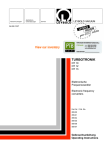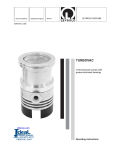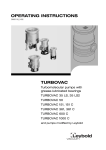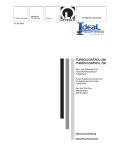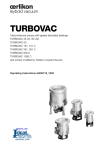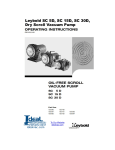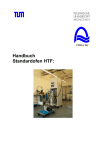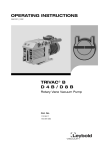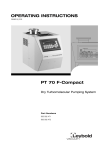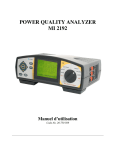Download Cooline PT360 Operating instructions
Transcript
Vacuum Solutions Application Support Service LEYBOLD VACUUM GA 05.218/3.02 TURBOTRONIK NT 340 M NT 340 MA NT 341 MA Electronic frequency converters Cat.No. 857 29/30/31 857 32 857 34 Operating Instructions Description Contents Description . . . . . . . . Design and Function . Standard Specification Technical Data . . . . . . Ordering Data . . . . . . 2 2.1 2.2 2.3 Connection . . . . . . . . . . . . . . . . . . . . . . . . . . 7 Setting the Mains Voltage . . . . . . . . . . . . . . . 7 Connecting the TURBOVAC . . . . . . . . . . . . . . 7 Connecting the Forevacuum Pump . . . . . . . . 7 2.4 TURBOTRONIK NT 340 M & MA without temperature control (TCU): Connecting the Cooling, Venting Device and the Flange Heater . . . . . . . . . . . . . . . . . 8 TURBOTRONIK NT 340 MA with temperature control (TCU): Connecting the Temperature Control and the Forevacuum Valve . . . . . . . . . . . . . . 10 TURBOTRONIK NT 341 MA: Connecting the Temperature Control and the Forevacuum Valve . . . . . . . . . . . . . . 12 2.5 2.6 . . . . . . . . . . . . . . . . . . . . . . . . . . . . . . . . . . . . . . . . . . . . . . . . . . . . . . . . . . . . . . . . . . . . . . . . . . . Page ...2 ...2 ...3 ...5 ...6 1 1.1 1.2 1.3 1.4 2.7 2.8 2.9 2.10 Connecting the Interface . . . . . . . . . . . . . . . 14 Connecting the Remote Control . . . . . . . . . . 14 Modifying the Relay “Failure” (Option) . . . . . 16 Installing the TURBOTRONIK . . . . . . . . . . . 16 3 3.1 3.2 3.3 3.4 3.5 3.6 3.7 3.8 3.9 Operation . . . . . . . . . . . . . . . . . . . . . . . . . . 18 Start-up . . . . . . . . . . . . . . . . . . . . . . . . . . . . 18 Start-up of the TURBOVAC . . . . . . . . . . . . . 18 Bakeout of the TURBOVAC . . . . . . . . . . . . . 18 Operation . . . . . . . . . . . . . . . . . . . . . . . . . . 19 Shut-down of the TURBOVAC . . . . . . . . . . . 19 Venting of the TURBOVAC . . . . . . . . . . . . . . 19 Power Failure - Linecord Interruption . . . . . . 19 Shut-down of the TURBOTRONIK . . . . . . . . 20 Maintenance . . . . . . . . . . . . . . . . . . . . . . . . 20 4 Troubleshooting . . . . . . . . . . . . . . . . . . . . . . 21 1 Description 1.1 Design and Function The TURBOTRONIK NT 340 M, NT 340 MA, and NT 341 MA are electronic frequency converters. They operate turbomolecular pumps TURBOVAC. The TURBOTRONIK NT 340 MA and NT 341 MA are prepared for operation with an additional temperature control unit. This temperature control unit is part of a temperature control which maintains the temperature of the TURBOVAC within a narrow control range. The TURBOTRONIK converts the single-phase mains voltage into a regulated DC power supply. The unit’s electronic circuitry then switches this DC power supply onto the four stator windings of the TURBOVAC’s commutatorless DC motor in a cyclical sequence. This electronic switching system uses Hall probes, and replaces the commutator normally found in DC motors. A digital controller keeps the speed of the motor constant. The TURBOTRONIK also powers and regulates the magnetic bearing unit. Switching the motor to the generator mode keeps the magnetic bearing unit in operation even in case of a mains power failure. Both the TURBOTRONIK and the TURBOVAC are fitted with sensors to ensure reliable operation of the entire system. External control and monitoring equipment e.g. the LEYBOTRONIK I can be connected via floating plugand-socket terminals located at the rear of the TURBOTRONIK. Both the remote control unit and the lines for the pump system’s status signals are connected here. These terminals also provide connections for controlling the forepump, the heater and valves. An RS-232 interface provides a further control and monitoring option. The unit also has a counter-current braking system for slowing down the pump when it is shut down. EC Conformance Declaration . . . . . . . . . . . . 22 Warning Indicates procedures that must be strictly observed to prevent hazards to persons. Caution Indicates procedures that must be strictly observed to prevent dam age to, or destruction of the appliance. Figures The references to diagrams, e. g. (2/10), consist of the Fig. No. and the Item No. in that order. We reserve the right to alter the design or any data given in these Op erating Instructions. The illustrations are not binding. 2 GA 05.218/3.02 - 11/97 Description 1.2 Standard Specifications TURBOTRONIK NT 340 M Mains voltage setting 230 V 120 V Cat. No. 857 29 857 30 for TURBOVAC 340 M, MC, 400 MC Standard Specification Power linecord, Miniature fuses: 2 T 8.0 A; 2 T 4.0 A; 2 T* 3.15 A; 2 T1.0 A; 2 T 0.5 A; 2 T 0.315 A 3 mains plugs, 2 terminal strips, 1 portable socket-outlet Mains voltage setting 100 V Cat. No. 857 31 for TURBOVAC 340 M, MC, 400 MC Standard Specification Power linecord, Miniature fuses: 2 T 4.0 A; 2 T 3.15 A; 2 T1.0 A; 2 T 0.5 A; 2 T 0.315 A 3 mains plugs, 2 terminal strips, 1 portable socket-outlet TURBOTRONIK NT 340 MA Mains voltage setting 120 V Cat. No. 857 32 for TURBOVAC 340 M, 340 MC 340 MCT 400 MC, 400 MCT Standard Specification Power linecord, Miniature fuses: 2 T 8.0 A; 2 T 0.5 A; TURBOTRONIK NT 341 MA Mains voltage setting 208 V Cat. No. 857 34 for TURBOVAC 341 MCT, 410 MCT Standard Specification Power linecord (mounted), Miniature fuses 4 T 5.0 A, 2 T 0.5 A Connection lines to the TURBOVAC do not belong to the standard specifications. *T= slow-blow GA 05.218/3.02 - 11/97 Fig. 1 Front panels of the TURBOTRONIK, explanation see table 1 and 2 3 Description Table 1: Operational Status Display of the Front Panel LEDs LED Color Display LOAD (LED chain) green LED “START” lights up: speed of the TURBOVAC (individual LED, linear display) LED “STOP” lights up: speed of the TURBOVAC (individual LED, linear display) LED “OVERLOAD” lights up: speed of the TURBOVAC (individual LED, linear display) LED “NORMAL” lights up: motor current (LED chain, logarithmic display) LED “FAILURE” lights up: failure code (one LED “LOAD” flashes) REMOTE yellow Lights up when the converter is controlled via the remote control inputs or via the interface; key manipulation is ignored. Flashes when control is possible both via keyboard and the RS 232 interface. POWER green Lights when mains power supply is on. NORMAL green Lights during normal operation, speed is above 95 % of the target speed Flashes in case of acceleration, braking and “OVERLOAD”. FAILURE red Lights in case of failure. Flickers in case of current peaks within the magnetic bearings. HEATING only on NT 340 M green Lights when heating is on. Flashes when heating has been preselected. HIGH SPEED only on NT 340 MA and NT 341 MA green Lights when the TURBOVAC runs with high speed (51,600 min-1). OVERLOAD yellow Lights in case of overload, i. e. speed is below 95 % of the target speed having finished the acceleration sequence. START green Lights in case of TURBOVAC’s acceleration. Flashes when the delay start-up time is active. STOP green Lights when the TURBOVAC brakes. Table 2: Functions of the Front Panel Keys Key Functions HEATING only on NT 340 M Switching the TURBOVAC’s heating on and off. HIGH SPEED only on NT 340 MA and NT 341 MA Selecting high or optimized speed for TURBOVAC. see Section 3.1. START Starting the TURBOVAC’s acceleration. STOP Braking the TURBOVAC. Resetting a failure report. 4 GA 05.218/3.02 - 11/97 Description 1.3 Technical Data Supply Outlets NT 340 M & MA 50/60 Hz Voltage value corresponds to mains voltage VALVE max. 20 VA HEATER max. 300 VA FAN max. 100 VA <1000 VA For 100 V and 120 V connection: sum of the supply outlets (VALVE, HEATER, FAN) max. 400 VA Mains voltage, with selector switch 100/120/220/240 V,+10%/-15% Mains frequency Power consumption including all connected units Power consumption of theTURBOVAC Rated speed of the TURBOVAC <400 VA 43,860 / 51,600 min-1 6,000 min-1 Minimum speed of the TURBOVAC Power output (motor) Nominal voltage Current limitation 50 V 7A Power output for the magnetic bearing Nominal voltage Current limitation ± 16 V ±7A RS 232/V.24 25-pin, D-shell, female 4,800 or 9,600 Operating temperature; with sufficient free convection 0-45°C (32°F - 113°F) Storage temperature -25°C...+70°C (-77°F - +158°F) Interference elemination ISM appliance group 1, Limit value class A according to EN 50081-2 / EN 55011 Control Inputs - digital, floating each terminal Interface Connector Baud rate 25 Veff AC max., 60 V DC versus protective conductor LEYBOTRONIK I compatible Interference resistance High level; between “+” and “-” terminal 13 V...33 V/max. 10 mA Electrostatic discharge (ESD) IEC 801-2, VDE 0843, Part 2 Low level; between “+” and “-” terminal 0 V...7 V Burst IEC 801-4, VDE 0843, Part 4 Level III Pulse duration for remote control active “START” pump, “STOP” pump, heater On/Off >200 ms high-energy impulse IEC 801-5, VDE 0843, Part 5 Level III Target speed analog input, not isolated Setting range Rated Speed Minimum Speed Weight 0...10 V 0V 10 V Control Outputs Relay 25 Veff AC, 60 V DC, 2 A/60 W/125 VA for normal operation operating contact for acceleration operating contact for failure resting contact, switchable to operating contact Severity 4 approx. 7 kg Temperature control unit: supply outlets Voltage corresponds to mains voltage Heating collar “HEATER” max. 120 W Cooling water magnetic valve “COOLER” max. 30 W Forevacuum valve “VALVE” max. 120 W Temperature control unit: fuses F1 and F2 F3 T 1.6 A T 0.315 A Analog voltage 0...10 V selectionable speed or motor current proportional Loadable max. 5 mA Standstill, no current corresponds to 0 V Rated speed, max. current corresponds to 10 V Reference voltage 15 V, max. 20 mA (not isolated for speed potentiometer and remote control inputs) Forevacuum pump “FOREPUMP”; Relay point GA 05.218/3.02 - 11/97 6 A, 750 VA, 250 V 5 Description (Front panel) (Housing) NT 340 M (Front panel) (Housing) NT 340 MA NT 341 MA similar Fig. 2a Dimensional drawings of TURBOTRONIK , dimensions in mm 1.4 Ordering Data Accessories for temperature control Ref. No. Pump system control LEYBOTRONIK I Power unit for LEYBOTRONIK I Delaying venting device Venting valve for delaying venting device 013 10 upon request 012 44 012 45 TURBOTRONIK NT 340 M Connection line set for connecting the TURBOVAC 3 m long 5 m long 10 m long 20 m long Connection line to the TURBOVAC bearing, 3 m long 6 859 20 859 22 Connection lines to the heater to the cooling water magnet valve (COOLER) to the valve to the temperature control unit (I/O) to the Pt 100 859 859 859 859 859 31 32 33 34 39 TURBOTRONIK NT 341 MA 857 857 857 857 70 71 72 73 Connection line to the TURBOVAC motor, 20 m long 859 12 Connection line to the TURBOVAC bearing, 20 m long 859 13 Accessories for temperature control TURBOTRONIK NT 340 MA Connection line to the TURBOVAC motor, 3 m long Temperature control unit (TCU) Temperature sensor Pt 100 859 10 859 11 Temperature control unit (TCU) Temperature sensor Pt 100 859 21 859 22 Connection lines to the valve to the temperature control unit (I/O) mains connection line to the temperature control unit to the Pt 100 to the cooling water magnet valve (COOLER) 859 33 859 34 859 35 859 36 859 37 GA 05.218/3.02 - 11/97 Connection (Front panel) (Housing) NT 340 MA with plugged-in temperature control unit Fig. 2b Dimensional drawings of TURBOTRONIK , dimensions in mm 2 Connection Warning Connections for forevacuum pump, cooling, venting valve and flange heater must be done by a qualified electrician in accordance with the applicable safety regulations. 2.1 Setting the Mains Voltage The TURBOTRONIK has been set at the factory for a mains power supply; see Section „1.2 Standard Specification“. To change this setting, remove the dummy plug (3/15) with a screwdriver and reinsert it according to the stamped-on voltage setting. The selected voltage indication must be in the immediate proximity of the arrow. If you do change the voltage setting, please also change the line power fuse accordingly; see the table. Fuses LINE VALVE HEATING FAN ———————————————————————— 100 V T*) 4.0 A T 0.315 A T 3.15 A T 1.0 A 120 V T 8.0 A T 0.315 A T 3.15 A T 1.0 A 220/240 V T 4.0 A T 0.315 A T 3.15 A T 1.0 A 2.2 Connecting the TURBOVAC Insert and fasten the connection line to the motor of the TURBOVAC at the socket DRIVE and to the TURBOVAC itself. Insert and fasten the connection line to the stabilizer and axial sensor of the TURBOVAC at the socket BEARING and to the TURBOVAC itself; both plugs are non-interchangeable. 2.3 Connecting the Forevacuum Pump Connect the forepump to the relay contact output FOREPUMP. When pressing the START key the contact is closed without any delay and the forepump is switched on. The forepump is shut down when the TURBOVAC has come to a standstill, switching examples see fig. 11. A starting delay for the TURBOVAC can be set at the potentiometer DELAY; see Section 3.1 (*) slow-blow) In case of need, other fuses may be installed for VALVE, HEATING and FAN. However, the sum of the fuses’ capacity for the three connections must not exceed: 4.5 A for 100/120 V 6.0 A for 220/240 V. Plug the power linecord into the socket (3/14), (5/15). The NT 341 MT has a fixed linecord. GA 05.218/3.02 - 11/97 7 Connection Key to Fig. 3 1 Power switch 2 Relay contact for forevacuum pump ON/OFF 3 Connection for supply of the TURBOVAC 4 LED red, magnetic bearing active 5 Connection for the magnetic bearing of the TURBOVAC 6 Connection socket for RS 232 interface 7 Connection terminal strip 8 Potentiometer for setting the delay time 9 Parameter selection for RS 232 interface 10 Connection for fan or solenoid valve for water cooling 11 Connection for heating 12 Fuses 13 Connection for venting valve 14 Connection for power linecord 15 Plug for selecting the mains voltages with integrated fuse Fig. 3 TURBOTRONIK NT 340 M & MA, rear panel 2.4 NT 340 M & NT 340 MA without temperature control: Connecting the Cooling, Venting Device and the Flange Heater Cooling The mains power supply to the socket (3/10) is switched on as soon as the TURBOVAC acceleration sequence begins; max. load 100 VA. The relevant fuse (3/12) is below the socket. The power supply to the socket is switched off once the TURBOVAC has come to a standstill and when the power switch is turned off. A magnetic valve for the water cooling or a fan can be connected to the socket (3/10). Venting The mains power supply to the socket (3/13) is switched on without any delay when START is activated. The power is turned off when STOP or FAILURE are activated; max. load 20 VA. The relevant fuse (3/12) is below the socket. 8 Caution Any interruption in power, no matter how short, will cause the pump to be vented. Power Failure Airing Valve If the TURBOVAC is operated without purge gas a power failure airing valve can be connected to socket (3/13) VALVE. Purge Gas- and Venting Valve When operating the TURBOVAC with purge gas it must be vented via the purge gas and venting valve. Delayed Venting Device and Venting Valve When shutting down or in case of a power failure the connection of the delayed venting device allows for setting the start and duration of the venting sequence in order to protect a system or a process-procedure. The presetting time can vary between 3 to 15 minutes. A short power failure does not entail an unwanted venting. Connect the delayed venting device to (3/13). GA 05.218/3.02 - 11/97 Connection HEATER VALVE N2 DRIVE BEARING FOREPUMP POWER FAN (COOLER) Fig. 4 Block wiring diagram for TURBOVAC 340 M & MC & 400 MC and NT 340 M & MA Flange Heater (Only for pumps with CF connection flange) The mains power supply to the socket (3/11) is switched on when HEATING is activated, provided that the pump operation status is NORMAL; max load 300 VA. The relevant fuse (3/12) is below the socket. Connect the flange heater to the TURBOVAC at socket (3/11) “HEATER”. GA 05.218/3.02 - 11/97 9 Connection Key to fig. 5 1 Power switch 2 Relay contact for forevacuum pump ON/OFF 3 Connection for supply of the TURBOVAC 4 LED red, magnetic bearing active 5 Connection for the magnetic bearing of the TURBOVAC 6 Connection socket for RS 232 interface 7 Connection terminal strip 8 Potentiometer for setting the delay time 9 Parameter selection for RS 232 interface 10 Connection for voltage supply of the temperature controller 11 Connection for cooling water magnetic valve 12 Connection for heating collar 13 Connection for forevacuum valve 14 Connection for Pt 100 15 Connection of the power linecord Fig. 5 TURBOTRONIK NT 340 MA with temperature control unit, rear panel Warning Prior to opening the temperature control unit pull it off. If the plug of the temperature control unit is connected there may be line voltage inside the unit. Fig. 6 Location of the fuses F1, F2, F3 in the temperature control unit; bottom removed Table 3: Temperature Control Unit: Pin assignment of the Sub D Sockets Sub D Socket VOLTAGE I/0 (Plug) Sub D Socket Pt 100 (Socket) Pin 1 Relay contact* Linked with pin 2 Pin 2 Voltage of the Pt 100 (0.1 V corresponds to 1 °C) Pt 100 Pin 3 Common point for the relay* Pt 100 Pin 4 Voltage treshold „NORMAL“ Linked with pin 3 Pin 5 Relay contact* Linked with pin 3 Pin 6 Earthed (of NT: pin 21 of the socket REMOTE) Linked with pin 2 Pin 7 Voltage treshold „Pump too cold“ Linked with pin 3 Pin 8 Voltage treshold „Pump too hot“ Linked with pin 3 Pin 9 + 15 V (of NT: pin 210 of the socket REMOTE) Voltage supply for temperature controller Linked with pin 3 * If the pump is too hot or too cold (FAILURE), the contact between pin 1 and 3 is closed and open between pin 3 and 5. In the operation mode NORMAL of the temperature controller the contact between pin 1 and 3 is open and closed between pin 3 and 5. Too hot: T > 75 °C (167°F); too cold: T < 55 °C (131°F); NORMAL: 55 °C ≤ T ≤ 75 °C (131°F ≤ T ≤ 167°F) 10 GA 05.218/3.02 - 11/97 Connection HEATER DRIVE N2 BEARING FOREPUMP TCU POWER COOLER VALVE Pt 100 Fig. 7 Block wiring diagram for TURBOVAC 340 MCT & 400 MCT and NT 340 MA with temperature control 2.5 NT 340 MA with temperature control: Connecting the Temperature Control and the Forevacuum Valve Forevacuum valve The socket VALVE is supplied with current provided the mains voltage is applied, max. rate: 120 W. A heater for a forevacuum valve can be connected to the socket. Temperature control The parts required for temperature control are listed in Section 1.4. Plug in the temperature control unit, see Fig. 5. The temperature control controls the temperature of the TURBOVAC 340 MCT & 400 MCT within a narrow control range. Connect the connection line to the heating collar at the heating collar of the TURBOVAC and at the socket HEATER. Plug in the connection line to the cooling water magnetic valve at the cooling water magnetic valve of the TURBOVAC and at the socket COOLER. Plug the connection line of the Pt 100 of the TURBOVAC into the socket Pt 100. Plug in the connection line temperature control unit TURBOTRONIK at the sockets VOLTAGE I/O and REMOTE. GA 05.218/3.02 - 11/97 11 Connection Key to Fig. 8 1 Power switch 2 Relay contact for forevacuum pump ON/OFF 3 Connection for supply of the TURBOVAC 4 LED red, magnetic bearing active 5 Connection for the magnetic bearing of the TURBOVAC 6 Connection socket for RS 232 interface 7 Connection terminal strip 8 Potentiometer for setting the delay time 9 Parameter selection for RS 232 interface 10 Power linecord 11 Fuses power supply Fig. 8 TURBOTRONIK NT 341 MA, rear panel 2.6 NT 341 MA: Connecting the Temperature Control and the Forevacuum Valve Temperature control The parts required for temperature control are listed in Section 1.4. Connect the connection line of the heating collar at the socket HEATER. Plug in the connection line to the cooling water magnetic valve at the cooling water magnetic valve of the TURBOVAC and at the socket COOLER. Plug the connection line of the Pt 100 of the TURBOVAC into the socket Pt100. Plug in the connection line temperature control unit TURBOTRONIK at the sockets VOLTAGE I/O and REMOTE. Install the temperature control unit. The temperature control controls the temperature of the TURBOVAC 341 MCT & 410 MCT within a narrow control range. The temperature control unit has to be connected to 120 V AC mains voltage. Warning Forevacuum valve The socket VALVE is supplied with current provided the mains voltage is applied, max. rate: 120 W. A heater for a forevacuum valve can be connected to the socket. The power supply must ensure that even in case of failure no lethal voltages may occur. 12 GA 05.218/3.02 - 11/97 Connection HEATER DRIVE N2 BEARING FOREPUMP POWER VALVE POWER TCU COOLER Pt 100 Fig. 9 Block wiring diagram for TURBOVAC 341 MCT & 410 MCT and NT 341 MA with temperature control COOLER HEATER VALVE POWER SUPPLY 4,4 60 7,6 31,8 25,5 VOLTAGE I/O Pt 100 127 138,5 Fig. 10 Temperature Control Unit, dimensions in mm GA 05.218/3.02 - 11/97 13 Connection 2.7 Connecting the Interface Inputs - Remote control active REMOTE Disables the keys and activates the remote control inputs (continuous signal; High-active) START pump Impulse or continuous signal; High-active STOP pump At DIP switch 1 you can choose whether the analog output voltage at the terminal strip REMOTE will rise proportionnally to the motor current or the speed. Impulse or continuous signal; Low-active HEATING Heating ON/OFF steady-state signal; High = On, Low = Off ON analog output = motor current LOAD. Speed (target value) OFF analog output = SPEED. Due to safety reasons the STOP function (Low-active) is dominant. A description of the interface for operating the TURBOTRONIK with a computer can be ordered under the description SB 05.207. The parameters for the interface will be set at the DIP switches. 2.8 Connecting the Remote Control Unit analog signal In order to start the TURBOTRONIK via the remote control: the REMOTE-inputs must be activated i.e. high-level between “+” and “-” terminal, For the signal assignments of the terminal strip REMOTE refer to fig. 12. the STOP-inputs must be inactivated i.e. high-level between “+” and “-” terminal, Switching examples see fig. 13. the START-inputs must be activated i.e. high-level between “+” and “-” terminal. Technical Data see section 1.3. Relay statuses see table 4. Note for Switching Example ON/OFF Switch If instead of the ON-OFF switch a jumper is established between Pin 4 and 20, the TURBOVAC will start up automatically once the TURBOTRONIK is switched on. Acceleration, Normal operation, Failure, Current-/speed actual value, The reference voltage is +15 V for speed potentiometer and remote control inputs. Caution The maximum permissible voltage at each of the terminals is 25 Veff AC, 60 V DC versus protective conductor. 14 Outputs The reference voltage is protected by the fuse F7. Position of the fuse se fig. 14. For changing the fuse open the TURBOTRONIK as described in section 2.9. GA 05.218/3.02 - 11/97 Connection Power <750 VA /single-phase Power >750 VA /single-phase three-phase Fig. 11 Switching examples for the motor connection of the forevacuum pump Key to Fig. 6 Inputs Inputs Outputs L=LOW; H=HIGH 13 14 15 16 17 18 19 20 21 22 1 2 3 4 5 6 7 8 9 10 11 12 Outputs REMOTE REMOTE “STOP” “STOP” not used not used “START” “START” HEATING HEATING not used not used “-” “+” “-” “+” “-” “+” “-” “+” H=active L=active H=active H=active NORMAL Target speed NORMAL attained FAILURE FAILURE Acceleration (ACCEL) Acceleration (ACCEL) not used +15 V earthed Analog output voltage 0...10 V 23 earthed 24 Speed target value, 10...0 V The inputs are opto-coupled Fig. 12 TURBOTRONIK rear panel; assigment of the terminal strip REMOTE Table 4 Relay status VALVE (3/13) HEATER (3/11) FAN (3/10) FOREPUMP (3/2) ACCEL Fig. 12 FAILURE Fig. 12 NORMAL Fig. 12 Power off open open open open open closed** open Standstill open open open open open closed** open Delayed start-up device closed open open closed closed closed** open Acceleration closed open closed closed closed closed** open NORMAL closed closed* closed closed open closed** closed Overload closed closed* closed closed open closed** closed Braking open open closed closed open closed** open Failure; TURBOVAC rotates open open closed closed open open** open Failure; TURBOVAC stands still open open open open open open** open * if selected ** modifications possible GA 05.218/3.02 - 11/97 15 Connection 2.9 Modifying the Relay FAILURE (Option) 2.10 Installing the TURBOTRONIK On delivery the relay FAILURE is a resting contact (normally closed). It can be changed to an operating contact (normally open). Install the TURBOTRONIK. Warning Before you open the TURBOTRONIK please first ensure that the TURBOVAC has been braked to a complete standstill, and that the mains power cord is disconnected. Since, nonetheless dangerous voltages may occur the unit must only be opened by a qualified electrician. The heat dissipation of the TURBOTRONIK must not be obstructed. Insure a sufficient ventilation - the ambient temperature during operation must not exceed 45°C (113°F). If - after installation - the rear of the TURBOTRONIK is no more accessible, switch on the POWER switch before mounting and if nec. set the starting delay; refer to section 3.1. Warning If the TURBOTRONIK is built into a rack the mains plug is not within easy reach. Therefore install a separation between the TURBOTRONIK and the mains when you build it into a rack. For modifying the relays, remove the fastening screw of the upper cover sheet at the rear and pull out the upper cover sheet. Modify the jumper (14/2). State of delivery Modification Warning resting contact 1-2 operating contact 2-3 Close the TURBOTRONIK again. We recommend noting all the modifications made on the unit itself or at least in the Operating Instructions for that particular instrument. 16 Do not operate the TURBOTRONIK with the standard mains lead in chemically aggressive surroundings. If you operate the TURBOTRONIK in chemically aggressive surroundings replace the mains lead by a resistant one. GA 05.218/3.02 - 11/97 Connection Terminals No. Terminals No. Terminals No. active = 13 V ... 33 V inactive = 0 V ... 7 V active = 0 V ... 7 V inactive = 13 V ... 33 V active = 13 V ... 33 V inactive = 0 V ... 7 V Active control with a voltage signal; LEYBOTRONIK I compatible Via continuous contact, remote control via key; passive control with contacts Via continuous contact, ON/OFF switch; passive control with contacts Fig. 13 Connection of the remote control Key to Fig. 14 1 Relay 2 Jumper 3 Connection plug for the RS 232 interface 4 Fuses F7 Fuse for 15 V at Pin 20 of the terminal strip REMOTE Fig. 14 Position of the jumper for the relay failure; top view into the TURBOTRONIK GA 05.218/3.02 - 11/97 17 Operation 3 Operation 3.1 Start-up Insert the power plug. Switch on the POWER switch. Having switched on the power switch the TURBOVAC’s stabilizer is activated and the rotor lifts up. Afterwards all LEDs light up for approx. 2 s for a functional check. The green LED „POWER“ remains on. On the TURBOTRONIK NT 340 MA and 341 MA with temperature control the temperature control is switched on. It is not necessary to check or to recalibrate the rotor position control system. Setting the Start-up Delay You can set a start-up delay for the TURBOVAC of up to five minutes at the rear of the TURBOTRONIC at DELAY. Due to the starting delay the TURBOVAC starts after the forevacuum pump. Selecting high or optimized speed (only on NT 340 MA & NT 341 MA) The TURBOVAC is designed for operation with optimized speed. In certain cases the standard speed which is set on delivery, can be increased (HIGH SPEED). Please contact your local Leybold service representative. Caution HIGH SPEED operation may result in shorter operational lifetime of the pump. Your warranty may be voided. 3.2 Start-up of the TURBOVAC Pressing the START key initiates the acceleration sequence; if a forevacuum pump is connected it will start up immediately. If a delay has been set, the START LED will flash during the delay period, after which it will remain on con tinuously and the TURBOVAC starts. The NORMAL LED flashes during acceleration. The LED chain indicates the increasing speed with one LED each. When 95% of the target speed has been reached, the LED NORMAL remains on continuously, the START LED extinguishes. During normal operation the LED chain indicates the course of the increasing motor power consumption; the increasing current (load) drawn by the TURBOVAC is indicated by the LED chain with one LED each lighting up after the other starting at the bottom and moving upwards. If the TURBOVAC exceeds the minimum speed within 8 minutes but does not attain 95 % of the target speed it will change to OVERLOAD operation. The LED OVERLOAD lights up and the LED chain indicates the speed. 3.3 Bake-out of the TURBOVAC (only for NT 340 M) Bake-out is only possible with the CF version during NORMAL operation. Pressing the HEATING key switches the flange heater ON and OFF. The green LED in the key lights up when the heating is ON. With preselection the LED flashes during the accelera tion phase; during NORMAL and activated heating the LED lights continuously. 18 GA 05.218/3.02 - 11/97 Operation 3.4 Operation During normal operation the TURBOVAC runs with target speed. The LED NORMAL lights and the LED chain shows - starting at the bottom and moving upwards the current consumed. In case of increased load (e.g. increased pressure due to a leak) the speed is compensated via an additional current consumption. Thus, the number of the lighting LEDs is a measure of the pressure rise. A further pressure rise beyond the point of the max. current limitation leads to a decreasing speed due to an increasing gas friction. 3.6 Venting of the TURBOVAC Vent the TURBOVAC every time the TURBOVAC is switched off in order to prevent a potential backstreaming of oil vapors from the forevacuum line to the highvacuum side. If a power failure airing valve or a delayed venting device is connected to the socket (3/13) VALVE the TURBOTRONIK controls venting automatically. The speed will likewise drop when the temperature of the TURBOVAC or TURBOTRONIK is too high, the LED OVERLOAD lights up. 3.7 Power Failure Linecord Interruption If the target speed drops below 95% the LED chain indicates the speed. The LED NORMAL flashes. If there is a power failure or if the power plug is accidentally disconnected, the TURBOTRONIK automatically switches over the drive of the TURBOVAC to generator operation. This means that during run-down of the pump, the active magnetic bearing regulation will be maintained until the rotor sets down on the touch-down bearings with the rate of rotation being low. If the speed drops below the minimum speed, the TURBOVAC is switched off and the LED FAILURE lights up. 3.5 Shut-down of the TURBOVAC Pressing the STOP key switches off the pump and the heater and activates braking. The forevacuum pump will be switched off provided it is connected via FOREPUMP; the TURBOVAC will be vented if the venting valve is connected via (3/13). The LED in the STOP key lights up, and the LED NORMAL flashes until the TURBOVAC stands still. The motor brakes the pump actively until it comes to a complete standstill; the speed is again indicated by the LED chain. If the connecting lines between the TURBOVAC and the TURBOTRONIK are interrupted, the automatic generator operation and the emergency power supply to the active magnetic bearing are put out of operation. In this case, the rotor is set down immediately onto the touchdown bearings, runs down with a considerable noise level and there is a risk that the touch-down bearings are damaged. The connection line to the TURBOTRONIK is secured against accidental interruption. If it is, nevertheless, interrupted e. g. by mechanical destruction, brake the TURBOVAC via venting until it stands still. If a malfunction occurs the FAILURE signal can be reset via the STOP key provided the cause of malfunction has been eliminated and the rotor of the TURBOVAC stands still. GA 05.218/3.02 - 11/97 19 Operation 3.8 Shutdown of the TURBOTRONIK Press the STOP key, and wait until the pump comes to a standstill. The LEDs in the keys START, STOP and NORMAL are extinguished. Switch the POWER switch to the “0” position. The temperature control at the TURBOTRONIK NT 340 MA and NT 341 MA with temperature control is switched off. If the red LED DON’T DISCONNECT has gone off the connection lines to the TURBOVAC can be disconnected in case of necessity. Caution Only after the pump has come to a standstill is the POWER switch to be switched to the “0” positon. In case of accidental shutdown, start up the pump at once. 3.9 Maintenance The TURBOTRONIK is maintenance-free. 20 GA 05.218/3.02 - 11/97 Troubleshooting 4 Troubleshooting When a malfunction occurs, the TURBOVAC is braked and the failure is indicated; see following table. The red LED FAILURE lights permanently and one green LED within the chain flashes. When the pump is at a complete standstill, and after you have eliminated the cause of the failure, you can reset the malfunction signal with the STOP command (key or remote control). Warning Before you open the TURBOTRONIK, please first ensure that the TURBOVAC has been braked to a complete standstill, and that the mains power cord is disconnected. Since, nonetheless dangerous voltages may occur the unit must only be opened by a qualified electrician. LED flashes Symptom Probable Cause Recommended Corrective Action ———————————————————————————————————————————————————————————————— No. 1 Linecord fault. Motor connection line incorrectly connected. Check the motor connection line and connect it (below) correctly. Motor connection line malfunctioning. Replace the motor connection line. ———————————————————————————————————————————————————————————————— No. 2 TURBOVAC is not TURBOTRONIK and TURBOVAC incompatible. Check the system. supported by the Loose contact in connection line. Repair the connection lines. TURBOTRONIK. ———————————————————————————————————————————————————————————————— No. 3 Not used ———————————————————————————————————————————————————————————————— No. 4 Speed below minimum or Forevacuum pressure >10-2 mbar. Check the forevacuum. has not been attained Pump blocked. Inform the Leybold after-sales service. during acceleration within High-vacuum pressure too high. Check the vacuum chamber. 8 minutes. ———————————————————————————————————————————————————————————————— No. 5 Temperature in the Frequent switching between acceleration and Let the TURBOTRONIK cool down. TURBOTRONIK too high. braking. Ambient temperature too high. Ensure an adequate ventilation. Forevacuum pressure >10-2 mbar. Operate the pump under normal load only. ———————————————————————————————————————————————————————————————— No. 6 Temperature in the Frequent switching between acceleration and Let the pump cool down and operate under TURBOVAC too high. braking. normal load only. Poor cooling or cooling line interrupted. Check the cooling. ———————————————————————————————————————————————————————————————— No. 7 Self test. Mains malfunction. Switch the mains off and then again on. EPROM malfunctioning. Inform the Leybold after-sales service. ———————————————————————————————————————————————————————————————— No. 8 Bearing malfunctioning. Venting curve not observed. Check the system. Pump incorrectly adjusted. Control the bearings. Pump or pump system vibration. Set up the pump system more quietly. Excess temperature in the TURBOTRONIK. Operate the pump under normal load only. Touch-down bearings worn. Inform the Leybold after-sales service. RF interference. Ground the TURBOTRONIK, locate the AC power cord in a separate bundle from the RF source, change the location of the TURBOTRONIK, if needed. ———————————————————————————————————————————————————————————————— No. 9 Not used. GA 05.218/3.02 - 11/97 21 EC Conformance Declaration • EC Low-Voltage Guidelines (73/23/EEC) • EEC Directive on Elektromagnetic Compatibility (89/336/EWG), measured with a typical test configuration Applicable, harmonized standards: • EN 61010-1: 1993 Designation of the product: • EN 50081-2: 1992 Electronic frequency converter • prEN 50082-2: 1992 Catalog numbers: 857 29/30/31 857 32 857 34 Applied national standards and technical specifications: • VDE 0411 Part 1/03.94 • VDE 0839 Part 81-2/03.93 • EVDE 0839 Part 82-2/01.93 LV.GT.0114.02.07.96 Models: TURBOTRONIK NT 340 M NT 340 MA NT 341 MA Cologne, July 5, 1996 ————————————————————— Mr. Beeck, Instruments Division Manager ————————————————————— Mr. Finke, Instruments Development 1.80.7.635.27 RSP 11.97 Cologne, July 5, 1996 Technical alterations reserved This declaration becomes invalid if modifications are made to the product without consultation with us. The products comply with the following guidelines: Printed in Germany on chlorine-free bleached paper We, the Leybold Vacuum GmbH, declare herewith that the products listed below, on the basis of their design and engineering as well as in the embodiment which we have placed on the market, comply with the applicable safety and health requirements set forth in EC guidelines. LEYBOLD VAKUUM GmbH Bonner Strasse 498 (Bayenthal) D-50968 Cologne Tel.: + 49 (221) 347-0 Fax: + 49 (221) 347-1250 http://www.leyboldvac.de e-mail:[email protected] GA 05.218/3.02 - 11/97






















